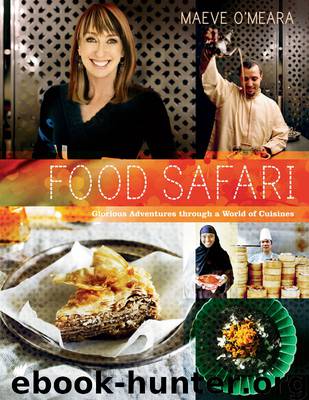Food Safari by Maeve O'Meara

Author:Maeve O'Meara
Language: eng, eng
Format: epub
Publisher: Hardie Grant Books
Published: 2012-11-25T16:00:00+00:00
MALAYSIA
If I could have my childhood over again, I’d grow up in Malaysia. Every expatriate I’ve spoken to sighs wistfully as they recall sumptuous banquets and simply prepared yet exquisite dishes. Like the story of the kway teow man, a mobile foodstall dedicated to a single great Malaysian offering – char kway teow noodles. This dish uses glossy, fat rice noodles mixed with plump, fresh prawns, thin discs of sweet–savoury Chinese lup cheong sausage, 140 sometimes a little diced chicken, bean sprouts, garlic chives and a dash of soy sauce and chilli. It’s all tossed together in a smoking-hot wok and the finishing touch is a beaten egg, which is whisked through to make a creamy sauce. The whole dish is made even more enticing by that special X-factor, the ‘breath of the wok’ – that’s the ‘char’ in the dish’s name. And to think that this wonder actually comes to your front doorstep – does it get better than that?
Char kway teow encapsulates the magic of Malaysian food – a layering of tastes and textures that is well thought-out, elegantly spiced, simply beautiful and a perfect blend of Indian, Malaysian, Chinese and Nyonya (Straits Chinese) flavours. Malaysia has a rich cultural mix and in a wider sense this dish allows a glimpse of the way the world could be, with many races existing harmoniously together.
Malaysian food is also the result of a whole nation of dedicated – no, obsessive – food lovers who focus on taste and texture to achieve culinary nirvana. This nirvana has been described to me by my chef friend Jess as ‘making your tastebuds jump up and down!’.
I had a glimpse of this nirvana when I discovered a flavour secret in the cheat’s laksa recipe that follows – not only does the base flavour of nutty sweetness come from the dried shrimp used, it’s also from the prawn heads and shells, which are cooked briefly in hot oil. What a revelation to see the oil change colour and catch the delicious aroma of the scraps that most of us would throw in the bin! In all these recipes I also found that you can get fairly close to authentic restaurant or hawker stall flavours at home when you know how.
The sweets that finish Malaysian meals are marvellous concoctions of rice flour, coconut and palm sugar. These take various forms, from the multicoloured steamed rice confections called kueh, to sago gula melaka in all its wonderfully sweet, dark stickiness. This is a great cuisine!
Download
This site does not store any files on its server. We only index and link to content provided by other sites. Please contact the content providers to delete copyright contents if any and email us, we'll remove relevant links or contents immediately.
| African | Asian |
| Canadian | Caribbean & West Indian |
| European | International |
| Latin American | Mexican |
| Middle Eastern | Native American |
| U.S. Regional |
Biscuits: A Savor the South Cookbook by Belinda Ellis(3904)
Al Roker's Hassle-Free Holiday Cookbook by Al Roker(3176)
A Jewish Baker's Pastry Secrets: Recipes from a New York Baking Legend for Strudel, Stollen, Danishes, Puff Pastry, and More by George Greenstein(3103)
Ottolenghi Simple by Yotam Ottolenghi(3037)
Trullo by Tim Siadatan(2986)
The French Women Don't Get Fat Cookbook by Mireille Guiliano(2982)
Better Homes and Gardens New Cookbook by Better Homes & Gardens(2952)
Bake with Anna Olson by Anna Olson(2930)
Panini by Carlo Middione(2824)
Hot Thai Kitchen by Pailin Chongchitnant(2808)
Nigella Bites (Nigella Collection) by Nigella Lawson(2770)
Momofuku by David Chang(2762)
Modern French Pastry: Innovative Techniques, Tools and Design by Cheryl Wakerhauser(2724)
Salt, Fat, Acid, Heat: Mastering the Elements of Good Cooking by Nosrat Samin(2658)
Tapas Revolution by Omar Allibhoy(2533)
Classic by Mary Berry(2501)
Solo Food by Janneke Vreugdenhil(2490)
Best of Jane Grigson by Jane Grigson(2467)
Okonomiyaki: Japanese Comfort Food by Saito Yoshio(2389)
